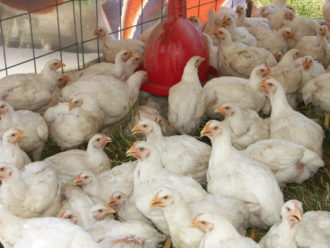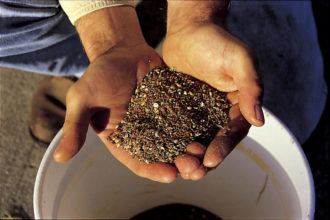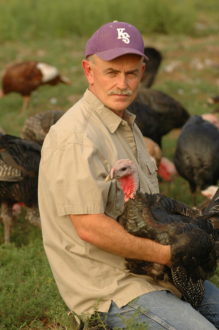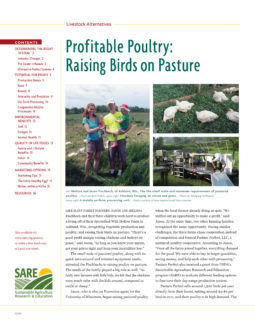PASTURED POULTRY ECONOMICS
Pastured poultry costs and returns vary widely. Before starting your operation, take advantage of budget tools available online. These calculators are used to estimate the economic return from your pastured poultry operation. They typically calculate revenue in terms of the number or weight of birds sold per year, and can include additional revenue from egg, feather and manure sales. Expenses include not only the usual costs for chicks, feed, medication, bedding, paid labor and processing, but also more complex costs, such as marketing, capital investment, equipment depreciation and the value of unpaid labor. Good calculator options include:
- Poultry Enterprise Budget, University of Wisconsin's Center for Integrated Agricultural Systems
SARE-funded researchers at Wisconsin’s CIAS studied five farms that raise poultry on pasture and found that the systems, while highly variable, yielded a significant profit for growers who incorporate poultry into diversified farms.
CIAS researcher Stevenson said that in the beginning, people make it work best at lower numbers, around 1,000 birds per season. But he cautions that the learning curve is about five years for a grower to become experienced. “By then, people know what they’re doing, their pastures are in shape, and they have figured out their management and equipment needs.”
Enterprise growth can be rapid initially on a pastured poultry farm, but it should never be rash. “The temptation is to get too big too fast,” said Spencer from NCAT, “and then a new farmer makes a big mistake on a large scale, and it wipes them out. Successful pastured poultry growers are good managers, and you can’t be a good manager until you’ve got some experience under your belt.”
“It all gets down to the customer,” said Paul Swanson, a Nebraska Extension educator specializing in sustainable agriculture who sees growing interest in pastured poultry. “To sell your product, you need a customer and a growing number of people who are interested in better-tasting, higher-quality chickens and don’t like the current system.”
Most farmers who have worked with Swanson on poultry enterprises already had crop farms, and many of them had beef cattle, too. They diversified to improve profits. “Chickens are a size that people don’t hesitate to purchase directly, as opposed to a quarter or half of beef,” Swanson said. “It’s an opportunity for farmers to try something without a very large investment.” Most pastured poultry farmers sell all of the birds they raise even before processing them.
Many direct-market producers find that poultry is a real lure that brings customers onto the farm, and many of them will buy more than just chicken or turkey when they are there.
Production Basics
Housing
The least expensive approaches are the portable field pens, pioneered by farmers in Europe more than a century ago, and more recently made popular in America by Joel Salatin and Andy Lee, though most producers concede they also demand the most time and labor. For pastured laying hens, open-faced sheds on skids, called colony houses, are a proven housing choice.
Salatin’s model also holds promise for producers who wish to raise poultry with low initial costs. Innovative farmers have adapted the Salatin design to fit their particular terrain and needs. In general, simple-to-build pens are made of inexpensive wood, sheet metal or plastic, and chicken wire. Making a 10-foot-by-12-foot pen—suitable for up to 80 mature chickens—should cost no more than $400, plus labor. Pens can be made less expensive if the roofing is salvaged.
One mobile pen model, invented by Homer Walden of Sunnyside Farm, near York, Pa., includes a novel wheel-and-pull system that makes it easier to move and can be used for either layers or broilers. The cost is about $450 to build.

At the other end of the spectrum are the portable houses favored by many farmers involved in day-range or free-range poultry production. Typically much larger and made of sturdier materials, they can cost significantly more. Lee designed and built structures he calls “mini-barns” for his day-range operation. They are made from lumber, plywood, corrugated tin and fiberglass, and have wooden runners, or “skids,” at their bases that allow them to be dragged with relative ease by tractor to fresh stands of the pasture when needed.
The chicken-tractor model, which Lee designed and describes in his book Chicken Tractor, calls for small numbers of birds to control weeds and insect pests, and increase fertility in garden plots. Simple and inexpensive, the tractor model might be the best way for someone with limited farming experience to begin raising poultry outdoors, although it is intended primarily to work in concert with vegetable production.
Salatin has designed coops on wheels that house laying hens, called eggmobiles. The eggmobile follows a herd of beef cattle, where the hens eagerly scratch apart cow patties to get at the fly grubs inside, reducing parasite numbers and providing nutrition for the laying flock. Spencer, the NCAT poultry specialist, built an eggmobile, constructing housing for his laying flock of 125 hens on top of an old haywagon chassis. “Parts of our place are really steep and having the layers on wheels lets us more easily move the flock from field to field. We just lock the hens in and we tow it wherever we need them. It helps us take better care of our pastures.”
Pasturing systems like Lee’s, where the chickens are not confined in the housing pens, are called day-range systems and usually depend on portable fencing to manage where the hens roam. Most producers favor electric fencing designed for poultry, called poultry netting, or feather netting. It costs about $160 per 164-foot roll (including step-in posts, but not the power source). The amount of poultry netting needed to manage a poultry flock is determined by several factors. The species, type (layer vs. broiler), age and breed of the bird, the flock density, and the condition of the pasture and health of the soil all dictate how much space to give the poultry being raised. “If the pasture’s getting hammered, there are too many birds on too small an area,” said Spencer. “If you pay attention to your pasture condition, you’ll know if and how you need to change. It’s pretty simple once you get an eye for it.” Spencer suggests two rolls of netting per 150 birds.
Brooders
Brooders are secure, climate-controlled areas where newly hatched chicks can live until sufficiently feathered to live outdoors. They are made of plywood, lumber and chicken wire, and contain warming lamps, drinking water containers, feeders and litter. A basic brooder that holds as many as 250 chicks can cost as little as $100 to construct.
Feed and Water Delivery
Beyond a brooder and field pen, producers only need containers for feed and water. They can be simple and inexpensive, even homemade. Ensure that any feeder or watering unit, whether made at home or purchased from a commercial source, does the job properly. Feed containers must be rodent-proof, as rodents’ access to the feed can spread salmonella. If the feed is stored outside or in the field, the containers must be waterproof. For example, improperly anchored or poorly designed feeders and watering units can be tipped over or clogged, increasing opportunities for spoilage and contamination as well as inducing unnecessary stress or endangering the lives of a flock. As pastured poultry enterprises grow, labor often becomes problematic. Producers raising large numbers of poultry design their feeding and watering systems to be as efficient as possible.
Feed

Most poultry diets contain corn for energy, soybeans combined with an animal or synthetic source for protein, as well as vitamin and mineral supplements. Some growers are switching to soy-free feeds in response to customers who want to avoid soy in their food chain. In well-managed pasture systems, producers very rarely use medications, as proper sanitation and a healthy growing environment help prevent health issues before they start. Consumers by and large appreciate poultry raised without antibiotics and other medications, an appreciation that is often reflected in their willingness to pay a premium price for pastured-poultry products.
Besides the feed in the feeder, free-range poultry have access to a buffet of forages, seeds, insects and other animals while on pasture. Joel Salatin estimates that his broilers forage for more than a quarter of their diet. Other producers guess feed savings of anywhere from 5-25 percent on pasture. When using low-quality feeds, the vitamins ingested when the birds forage on grasses and forbs can balance out nutritional deficiencies in the feed ration. “There are a lot of environmental and management factors that affect how much food’s out there for your birds,” said Spencer. “Soil fertility, bird genetics, management style, climate, time of season and unexpected things like drought, flooding, late/early frosts—all of these can throw a major wrench in your operation if you don’t plan ahead.”
Where pastured-poultry farmers source their feed is as diverse as the farmers themselves. Often pastured-poultry producers begin with prepared rations from their local feed store. As the operation grows, producers often buy feed in bulk, enabling them to purchase top-quality feeds, including organic, soy-free and GMO-free (not genetically modified) if that is part of the operation, for prices comparable to conventional feeds. Some producers, both small and large, mix and grind their own feed. Ration recipes can be found in books, websites and listservs dedicated to pastured- and range-poultry operations.
Whatever route you take—ready-mixed feed or preparing your own blend—expect the cost will likely range between 15-50 cents per pound for conventional and GMO-free rations. Cornish Cross meat birds will ingest roughly 10-15 pounds of feed each before reaching market weight, which means the typical cost of feeding each bird will range from $2-$6 during its seven- to eight-week lifetime (or longer for slower growing breeds). The most productive laying hens consume around 25 pounds of feed to get to the point of lay.
When evaluating feed options, consider:
- Organic feeds are increasingly available from mills and suppliers. Expect to pay two to four times the cost of conventional rations.
- Some feeds are medicated to combat coccidiosis, which is particularly devastating to chicks; experienced farmers typically find that clean brooders, deep litter and clean living conditions make medicated feeds unnecessary.
- Feeds can be ordered in various forms, such as cracked, mashed and pelletized. Healthy debate rages as to which form is better for pastured birds. The process of making feed crumbles and pellets heats the feed, destroying heat-sensitive vitamins, yet some argue that heat and pressure free up other nutrients and make them available to birds. Ground feed is not typically heat treated, but more feed can be wasted through spillage in the field. Many producers report that the higher cost of high-quality feed is often offset by lower consumption rates as the birds eat less to get the nutrition they need.
- Some producers have found that vitamin supplements help reduce mortality, with their costs being more than offset by greater flock productivity.
Breeds
Most pastured poultry producers have adopted the same breed of meat bird as their confinement counterparts: the Cornish Cross. Developed for its large breast, large appetite and rapid development, the Cornish Cross also boasts a mild flavor that is familiar and appealing to most consumers.

Virginia homesteader and author of The Small-Scale Poultry Flock Harvey Ussery and his wife are experimenting with hardier varieties of birds, such as New Hampshire's and Plymouth Rocks. Even though these varieties take longer to reach butchering weight, the meat boasts more flavor. Ussery wants to educate consumers about alternatives to Cornish Cross. He said the fast growth of the Cornish Cross strains the birds’ hearts, digestive systems and leg joints. Moreover, birds more suited to foraging eat less supplemental feed. The Livestock Conservancy also recommends Plymouth Rocks, as well as Delawares, as heritage broiler breeds that perform well on pasture.
Ussery, writing in Grit!, the American Pastured Poultry Producers Association (APPPA) newsletter, details the problems he encountered with the Cornish Cross. Cornish Cross chicks from nearly all hatcheries in the country come from the same stock. The variety, he argues, is ill-suited for raising outdoors because it has been bred for confinement. Properties that make for good and efficient foragers, he said, have been “selected out” because they are not needed in confinement production models.
The only appeal of the Cornish Cross, he said, is its ability to arrive at market weight in a period of about seven weeks. Emphasis on that single quality has neglected other important factors, such as flavor, texture, vigor, health and a bird’s ability to take full advantage of all the benefits available to it on pasture.
But not all Cornish Cross strains are equal on pasture. Older (commercially called “low-yield”) strains of Cornish Cross, such as the occasionally black-flecked feathered Cobb 500 or the Ross 308, tend to do better on pasture and are more forgiving on lower-quality nutrition than the newer (“high-yield”) varieties, such as the Cobb 700.
Many producers are finding a compromise between the accelerated growth of the Cornish Cross and the lower feed conversion and dress-out weights of the older heritage breeds. Several varieties of broilers with names like Freedom Rangers, Red Rangers and Rosambros have been selected for high growth rates and hardiness for living outdoors on range. These birds are raised a few weeks longer than the Cornish Cross to reach comparable weights, typically nine to 12 weeks, but have a different texture and flavor profile than their industrial counterparts. “We love them,” said NCAT’s Spencer. “You sacrifice a little breast meat and accept a little more grow-out time, but we’ve never had a complaint, just a lot of compliments, and it differentiates us from anything our customers can find in the stores.”
Some pastured-poultry producers report that they are growing and selling the Cornish Cross side by side with broiler strains bred for pastured production. They often find that more discriminating customers offer little resistance to paying 50 cents per pound more for the flavorful meat of the latter.
Layers
There is no overwhelmingly favored variety of laying hen for range poultry production. Several breeds, including heritage breeds like Leghorns, Anconas and Minorcas, and highly productive hybrids like commercial Leghorn varieties, supply exceptional numbers of eggs, according to Kelly Klober, a SARE grantee and author of the book Talking Chicken. Egg colors are a regional preference, with brown eggs often—and erroneously—being identified as true farm eggs. Some producers are finding niche markets with heritage layers, such as the Americauna and Araucana, which lay blue-shelled eggs popular at Easter. The biggest pitfall in selling eggs is failing to price them correctly: Ensuring that all input and labor costs are reflected in the final price is critical for economic success with layers.
Turkeys
The “Cornish Cross” of turkeys is the Broad Breasted White. Again borrowed from the confinement industry, the Broad Breasted is a fast-growing bird that takes about four months to reach market weights of about 18-22 pounds. Many who have raised turkeys say they are more manageable in many ways than broilers, and that they forage much more aggressively than chickens. Unlike the Cornish Cross, the Broad Breasted White and Bronze varieties of turkeys maintain much of their turkey instincts and behaviors.
Joleen Marquardt, a pastured-poultry producer in Pine Bluff, Wyo., said she and her children were at first intimidated by the sheer size of their turkeys at processing time, but found them more docile than broilers. “The weight gets to be a little much after a full day of processing, but it’s not nearly as bad as I anticipated,” she said.
The alternative to the Broad Breasted turkeys are the traditional heritage turkey breeds. Heritage breeds take longer to grow out, but develop a flavorful carcass with less breast meat and much more dark meat. Varieties include the Bourbon Red, Spanish Black, the Bronze and the Royal Palm. More are listed, along with useful information about turkey and other heritage-poultry production, on the website of the The Livestock Conservancy.
Mortality and Predation
More important than the breed of broiler, layer or turkey is an assurance that the birds live to be profitable on the farm. Critically important in any pastured-poultry operation is that mortality rates must be controlled. New producers typically have high rates of mortality—sometimes as high as 10-30 percent; experienced farmers often have mortality rates of 2 percent or lower.
In the brooder, mortality occurs for a number of reasons. Typically, chicks are air-freighted and then shipped by truck, so any delay in shipping can cause problems in the brooder. Poultry chicks typically have a nutrition reservoir of around three days as they absorb the remnants of their egg yolks. The sooner chicks are given access to food, water and a heat source, the better. Piling, a common mortality factor, is the result of scared or frantic chicks or older birds rushing to a corner of a brooder or pen. As the birds pile on top of each other, the bottom birds get smothered and die from suffocation. Often, producers will use rounded corners in the brooder to avoid this problem.
It is common, especially among inexperienced pen producers, for birds to be crushed or injured when field pens are moved to new stands of grass. This is less of a concern for producers using one of the systems that do not require frequent moving of the housing. As producers and a given flock become more experienced, the birds become accustomed to frequent movement of their pens and learn to walk with them.
The other major factor in premature loss of birds is predation. Due to their small size, chickens are a favorite not only of people, but also of nearly every predator in the wild. Flocks raised in a field-pen system tend to be safer from daytime predators such as dogs, hawks, and the occasional eagle because they are securely enclosed. Nocturnal predators such as raccoons, foxes, coyotes, owls, and skunks, however, will exploit even the smallest opening in the pen. Even the most experienced producers say they have lost a few birds.
Range poultry, on the other hand, are much more vulnerable to avian predation. Alabama day-range producer Charles Ritch, for example, said hawks and owls are “a big, big problem, and they have been ever since I started.” He pegs his predation losses at about 5 percent each season.
Producers with the most success rely on multiple layers of protection to keep their poultry safe. When combined, protective measures such as livestock guardian dogs, electric poultry netting and perimeter fencing often play a synergistic role in keeping mortality down and poultry profits up.
Most producers expect some premature loss from each flock despite working to reduce mortality. To minimize loss:
- Provide sufficient warmth, water, and feed, especially in the crucial first days after you receive your shipment of chicks.
- Place pens well inside pastures rather than along wooded fence lines, because many predators are reluctant to travel across the open territory.
- Consider installing electric fences and/or using a trained dog.
